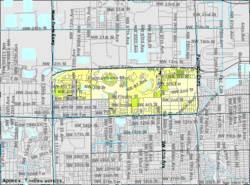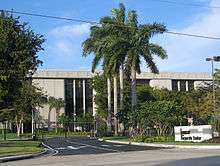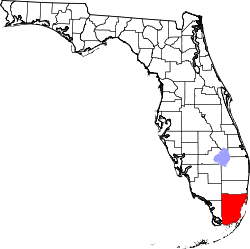Fontainebleau, Florida
Fontainebleau (also spelled Fountainebleau) is a census-designated place (CDP) in Miami-Dade County, Florida, United States. The population was 59,764 at the 2010 census.
Fontainebleau, Florida | |
|---|---|
 Location in Miami-Dade County and the state of Florida | |
 U.S. Census Bureau map showing CDP boundaries | |
| Coordinates: 25°46′13″N 80°20′45″W | |
| Country | |
| State | |
| County | Miami-Dade |
| Area | |
| • Total | 4.5 sq mi (11.7 km2) |
| • Land | 4.4 sq mi (11.4 km2) |
| • Water | 0.1 sq mi (0.3 km2) |
| Elevation | 3 ft (1 m) |
| Population (2000) | |
| • Total | 59,549 |
| • Density | 13,233.1/sq mi (5,089.7/km2) |
| Time zone | UTC-5 (Eastern (EST)) |
| • Summer (DST) | UTC-4 (EDT) |
| FIPS code | 12-24562[1] |
| GNIS feature ID | 1853252[2] |
Geography
Fontainebleau is located at 25°46′13″N 80°20′45″W (25.770144, -80.345917).[3]
According to the United States Census Bureau, the CDP has a total area of 4.5 square miles (12 km2), of which, 4.4 square miles (11 km2) of it is land and 0.1 square miles (0.26 km2) of it (2.43%) is water.
Economy

Lennar Corporation[4] has its headquarters in Fontainebleau.
Demographics
| Historical population | |||
|---|---|---|---|
| Census | Pop. | %± | |
| 2000 | 59,549 | — | |
| 2010 | 59,764 | 0.4% | |
| source:[5] | |||
| Demographics | |||
|---|---|---|---|
| 2010 Census | Fontainebleau | Miami-Dade County | Florida |
| Total population | 59,764 | 2,496,435 | 18,801,310 |
| Population, percent change, 2000 to 2010 | +0.4% | +10.8% | +17.6% |
| Population density | 14,030.5/sq mi | 1,315.5/sq mi | 350.6/sq mi |
| White or Caucasian (including White Hispanic) | 91.2% | 73.8% | 75.0% |
| (Non-Hispanic White or Caucasian) | 4.2% | 15.4% | 57.9% |
| Black or African-American | 2.2% | 18.9% | 16.0% |
| Hispanic or Latino (of any race) | 94.7% | 65.0% | 22.5% |
| Asian | 1.5% | 1.5% | 2.4% |
| Native American or Native Alaskan | 0.1% | 0.2% | 0.4% |
| Pacific Islander or Native Hawaiian | 0.0% | 0.0% | 0.1% |
| Two or more races (Multiracial) | 2.0% | 2.4% | 2.5% |
| Some Other Race | 4.5% | 3.2% | 3.6% |
As of 2010, there were 23,181 households, with 6.5% being vacant. In 2000, 34.9% had children under the age of 18 living with them, 49.6% were married couples living together, 18.6% had a female householder with no husband present, and 25.4% were non-families. 18.4% of all households were made up of individuals and 6.1% had someone living alone who was 65 years of age or older. The average household size was 2.85 and the average family size was 3.22.
In 2000, the CDP the population was spread out with 22.7% under the age of 18, 9.8% from 18 to 24, 34.0% from 25 to 44, 21.0% from 45 to 64, and 12.4% who were 65 years of age or older. The median age was 35 years. For every 100 females, there were 86.9 males. For every 100 females age 18 and over, there were 82.7 males.
In 2000, the median income for a household in the CDP was $35,509, and the median income for a family was $36,161. Males had a median income of $27,380 versus $22,143 for females. The per capita income for the CDP was $14,716. About 11.9% of families and 14.2% of the population were below the poverty line, including 18.7% of those under age 18 and 15.5% of those age 65 or over.
As of 2000, speakers of Spanish accounted for 91.29% of residents, while this who spoke only English made up 6.25%.[6]
As of 2000, Fontainebleau had the second highest percentage of Nicaraguan residents in the US, with 9.44% of the populace (the highest percentage being Sweetwater, Florida, at 16.63%.)[7] It had the fourteenth highest percentage of Cuban residents in the US, at 37.29%,[8] and the eighteenth highest percentage of Colombian residents in the US, at 5.29% of its population (tied with North Bay Village.)[9] It also had the third most Venezuelans in the US, at 3.14% (tied with The Hammocks, Florida,)[10] while it had the fortieth highest percentage of Dominicans, at 2.99% of all residents (tied with Methuen, Massachusetts.)[11] Fontainebleau's Peruvian community had the thirtieth highest percentage of residents, which was at 1.75%.[12] It's also home to the forty-third highest percentage of Honduran residents in the US, at 1.09% of the population (tied with South Miami Heights, Florida.)[13]
History
The mainland neighborhood takes its name from the famed Miami Beach resort. In 1970, Ben Novack, the Fontainebleau's original owner, grew jealous of Doris and Alfred Kaskel's plans in Doral and wanted to create his own planned golf course, resort, and community. It was to be known as Fontainebleau Park. Novack, however, soon fell into financial problems (and the Fontainebleau Park would play a part in the hotel's foreclosure in 1977). The company Trafalgar Developers would go on to develop the community under the "Fontainebleau" name, but no link to the famed hotel would ever be mentioned in or promotional materials when the community opened in the '70s.[14]
The community of Fontainebleau Park itself was a collection of sub-divided villages around 2-18 holes golf courses. (East and West course now closed and built upon).[15] The original sales office for Trafalgar Development was located at what is now the Fontainebleau Office Park located at the main Fontainebleau Park entrance and West Flagler Street. Fontainebleau Park West's sales office (West of N.W. 97th Ave) at what is now "Soleil Condominiums". While the Eastern half of the community was heavily designed for condominiums and apartments, the Western portion of the community included "Village Homes", Single-Family Homes, "Garden Homes", and Townhomes.
Education
Miami-Dade County Public Schools operates public schools in the Fountainbleau area. Charles R. Hadley Elementary School, Seminole Elementary School, and E.W.F. Stirrup Elementary School, and Ruben Dario Middle School are in Fontainebleau.[16]
Miami Christian School and Vann Academy are in Fontainebleau.[16]
The Roman Catholic Archdiocese of Miami previously operated Our Lady of Divine Providence School in Fontainebleau CDP.[17][18] It closed in 2009.[19]
References
- "U.S. Census website". United States Census Bureau. Retrieved 2008-01-31.
- "US Board on Geographic Names". United States Geological Survey. 2007-10-25. Retrieved 2008-01-31.
- "US Gazetteer files: 2010, 2000, and 1990". United States Census Bureau. 2011-02-12. Retrieved 2011-04-23.
- "Legal Notices." Lennar Corporation. Retrieved on January 9, 2010.
- "CENSUS OF POPULATION AND HOUSING (1790-2000)". U.S. Census Bureau. Retrieved 2010-07-17.
- "MLA Data Center Results of Fountainbleau, FL". Modern Language Association. Retrieved 2007-11-06.
- "Ancestry Map of Nicaraguan Communities". Epodunk.com. Archived from the original on 2010-10-17. Retrieved 2007-11-06.
- "Ancestry Map of Cuban Communities". Epodunk.com. Retrieved 2007-11-06.
- "Ancestry Map of Colombian Communities". Epodunk.com. Retrieved 2007-11-06.
- "Ancestry Map of Venezuelan Communities". Epodunk.com. Retrieved 2007-11-06.
- "Ancestry Map of Dominican Communities". Epodunk.com. Retrieved 2007-11-06.
- "Ancestry Map of Peruvian Communities". Epodunk.com. Archived from the original on 2007-10-11. Retrieved 2007-11-06.
- "Ancestry Map of Honduran Communities". Epodunk.com. Archived from the original on 2010-10-17. Retrieved 2007-11-06.
- Munzenrieder, Kyle (2016-01-28). "The Stories Behind the Names of 25 Miami-Dade Cities and Neighborhoods". Miami New Times. Retrieved 2018-04-17.
- "Best Golf Courses North America | Discount Tee-Time | Golf Course Ranking". golfcourseranking.com. Retrieved 2018-04-17.
- "Fountainbleau CDP, Florida." U.S. Census Bureau. Retrieved on January 7, 2010.
- "Our Lady of Divine Providence". Roman Catholic Archdiocese of Miami. 2003-12-30. Retrieved 2020-05-10.
Our Lady of Divine Providence 10207 West Flagler Street Miami, Florida 33174
- "2000 Census Block Map: Fontainebleau CDP" (PDF). U.S. Census Bureau. Retrieved 2020-05-10. - The area with Our Lady of Divine Providence is on page 2
- Johnson, Akilah (2009-01-23). "Six schools to close as Archdiocese retrenches". South Florida Sun Sentinel. Retrieved 2020-05-10. - The article identifies Our Lady of Divine Providence as being in Sweetwater though as of 2000 it was in the Fontainebleau CDP (location seen here)

